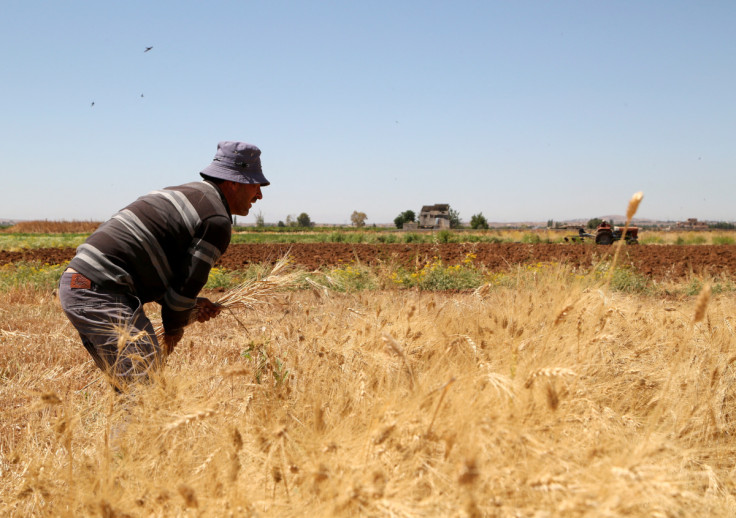Exclusive-Climate Change, Conflict Decimate Syria's Grain Crop - UN FAO

Climate change, a faltering economy and residual security issues have decimated Syria's 2022 grain crop, leaving the majority of its farmers in a precarious position, the United Nations Food and Agriculture Organization (FAO) said.
Syria's 2022 wheat harvest amounted to around 1 million tonnes, down some 75% from pre-crisis volumes, while barley was almost non-existent, Mike Robson, FAO's Syria Representative told Reuters.
Erratic rainfall patterns in the past two seasons have shrunk Syria's wheat crop from around 4 million tonnes annually pre-war, enough to feed itself and export to neighbouring countries in a good year.
Now after more than a decade of conflict many farmers are struggling with harsh economic conditions and security issues in some areas while having to adapt to the new realities of changing weather conditions.
The meagre harvest adds strain on Syria's sanctions-hit government as it struggles to source wheat from the international market. Food is not restricted by Western sanctions but banking restrictions and asset freezes have made it difficult for most trading houses to do business with Damascus.
International import tenders conducted by the state's main grain buyer, Hoboob, have repeatedly failed in previous years with most wheat sourced from ally Russia.
Global wheat prices have also surged since February, after Moscow's invasion of Ukraine halted grain exports from the Black Sea for months.
"Climate change isn't easy anyway but it is doubly not easy in a place like Syria with high inflation, no power, no good quality inputs and some residual security issues that are still playing up in parts of the country," Robson said.
The bulk of Syria's wheat crop, or around 70%, relies on rainfall with irrigation underdeveloped due to war.
Compared to planted areas, the harvest was around 15% of what farmers expected of the rainfed wheat areas.
"When the rain fell it was concentrated and it didn't follow traditional patters," Robson said.
"A late start to the rainfall meant that farmers were delayed in planting and they couldn't prepare their land in time and then the rains finished early by March," he said.
Farmers in Syria typically plant their wheat crop around November-December and harvest in May-June.
Syria's economy is also faltering under the weight of its complex, multi-sided conflict, now in its twelfth year.
The collapse of the Syrian pound has driven up the price of good quality fertilizers, seeds and fuel needed to power water pumps. On Monday, Syria further weakened its official exchange rate to the U.S. dollar by roughly seven percent.
The productivity of one hectare of wheat planted in irrigated lands should be around three to four tonnes but is currently at only around two as farmers struggle with agricultural inputs.
PRECARIOUS EXISTENCE
The one million tonne production figure is far lower than government estimates of around 1.7 million tonnes.
The government did not immediately respond to a request for comment on the figures.
The FAO estimate translates into a need to import around 2 million tonnes from abroad to feed government-controlled areas.
A drop in global wheat prices in August, partly on the back of grain exports resuming from Ukraine under a July deal between Kyiv and Moscow makes the situation less dire than a couple of months ago but there are still concerns over the government's ability to provide funding for purchases.
"The (international) market is slowly getting back to functioning but I'm still concerned as obviously there's a need for foreign exchange to buy the wheat," Robson said.
With the barley crop also failing, some sheep herders are choosing to de-stock, selling most of their animals as they are unable to feed them.
Syria used to be able to produce around 4-5 million tonnes of feed barley a year to feed its livestock but this year many are struggling to keep their livelihood.
"When they needed to buy feed, sheep farmers used to sell one animal to buy a tonne of barley for instance and they can feed 20 with that," Robson said.
"This year they would need to sell 10 animals."
The effects are already being felt in the food market where poultry meat is now selling for more than lamb as financially struggling farmers continue to sell their sheep.
"The price will go way down but then it will become in short supply and it will be a real problem," Robson said.
Areas that are relatively lush in winter and could be used for grazing animals are plagued with lingering security issues and so livestock keepers prefer not to venture there.
Farmers who have been unable to make a profit for the past couple of years are now worn out financially and may consider other livelihoods as opposed to taking on more debt to grow more grains.
"It is a very uncertain and precarious existence farming in rainfed conditions right now."
© Copyright Thomson Reuters 2024. All rights reserved.











